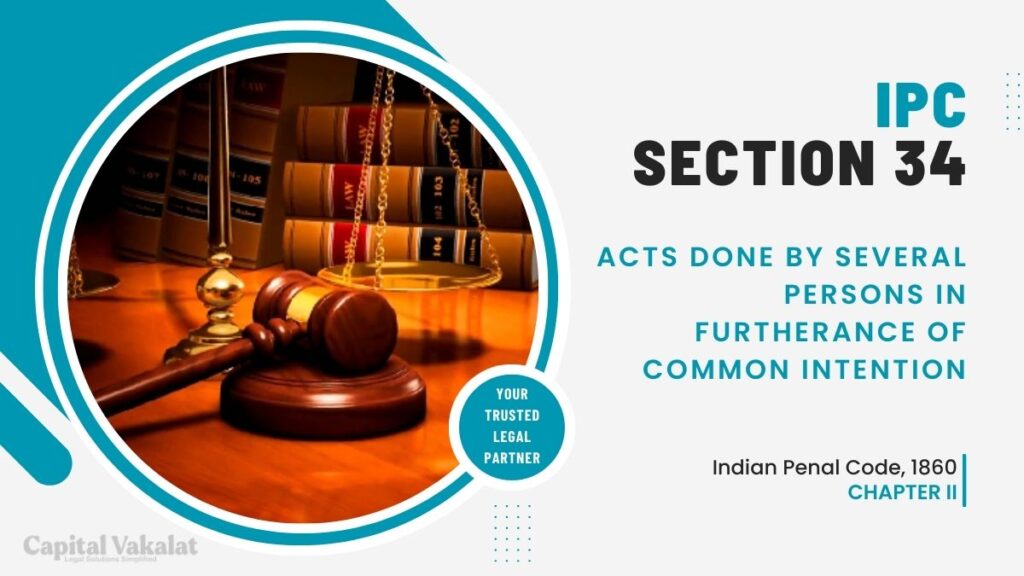In the realm of criminal law, the Indian Penal Code (IPC) holds a significant place, outlining various offenses and their consequences. Section 34 of the IPC is a crucial provision that deals with acts done by several persons in furtherance of a common intention.

This legal principle plays a pivotal role in determining the liability of individuals who act collectively to commit an offense. Let’s delve deeper into the intricacies of Section 34 IPC and its implications.
Understanding Common Intention
Defining the Concept
At its core, a common intention refers to a shared resolve or plan between two or more individuals to commit a criminal act. Section 34 of the IPC recognizes that when a criminal act is committed by a group of people with a common intention, each member of the group is held equally liable, even if their specific role in the offense differs.
Extent of Liability
Section 34 establishes a principle of joint liability. This means that if a criminal act is committed by multiple individuals in furtherance of their common intention, each person is considered equally responsible for the entire act. This provision ensures that the law doesn’t allow any member of the group to escape liability by claiming a lesser role or a lack of direct involvement.
Key Elements of Section 34
Common Intention vs. Common Object
It’s important to distinguish between common intention and common object. While common intention relates to the shared plan to commit a specific crime, common object pertains to the ultimate goal of the criminal activity. Section 34 focuses primarily on common intention, holding all participants accountable for the acts committed in furtherance of this shared intent.
Criminal Act and Common Intention
For Section 34 to apply, there must be a criminal act committed by multiple individuals. Additionally, these individuals must have acted in furtherance of their common intention. This provision doesn’t concern itself with the prior arrangement; it’s concerned with the actions taken during the commission of the offense.
Application of Section 34
Real-Life Examples
To better understand the application of Section 34, consider a scenario where a group of individuals plans to rob a bank. If, during the robbery, one of the individuals accidentally kills a security guard, all members of the group can be held equally responsible for the murder. This is because their shared intention to commit robbery led to the fatal consequence.
Scope and Limitations
While Section 34 is broad in its scope, it has its limitations. The provision cannot be invoked in cases where there is no shared intention or where the actions of the individuals are independent of each other. Additionally, the principle of joint liability doesn’t extend to cases where a person’s involvement can be clearly isolated from the common intention.
Legal Precedents
Landmark Cases
Over the years, Section 34 has been applied in various legal cases to ensure that justice is served. Landmark cases like Barendra Kumar Ghosh v. King-Emperor and Mahbub Shah v. Emperor have contributed to shaping the interpretation of this provision and establishing its significance in criminal law.
Ensuring Fairness and Accountability
Section 34 of the IPC plays a pivotal role in ensuring fairness and accountability in cases where multiple individuals collaborate to commit a crime. By holding all participants equally liable for the consequences of their shared intention, the provision prevents any undue advantage to those who might attempt to evade liability based on their specific role.
Conclusion
In the intricate web of criminal law, Section 34 of the IPC stands as a guardian of justice, ensuring that individuals who act in concert to commit a crime are held accountable for their actions. This provision embodies the principle that shared intent leads to shared liability, reinforcing the idea that no one can escape the consequences of their actions simply by pointing to their role. As we navigate the legal landscape, it’s essential to remember that the law values not only individual actions but also the collective intentions that drive them.
Certainly! Here are some external resources that provide more details on the topic of: Section 34 IPC: Acts Done by Several Persons in Furtherance of Common Intention.
- Indian Penal Code – Section 34
Access the full text of Section 34 of the Indian Penal Code for an in-depth understanding of the provision’s legal implications. - Section 34 IPC – Understanding Common Intention
Dive into an insightful article that breaks down the concept of common intention under Section 34 IPC and its practical applications. - LiveLaw – Landmark Cases on Section 34 IPC
Explore notable legal cases that have shaped the interpretation of Section 34 IPC and its significance in criminal law. - Vakilsearch – Joint Liability in Criminal Law
Learn more about joint liability in criminal law and how Section 34 IPC addresses the actions of individuals acting in concert.
FAQs
Does Section 34 apply to civil cases as well?
No, Section 34 is specifically related to criminal cases and the joint liability of individuals in committing criminal acts.
What’s the difference between common intention and common object?
Common intention refers to the shared plan to commit a specific crime, while common object relates to the ultimate goal of the criminal activity.
Can a person be held liable under Section 34 if they had a minor role in the crime?
Yes, Section 34 holds all individuals equally liable for the criminal act committed in furtherance of common intention, regardless of their specific roles.
Are there any exceptions to the application of Section 34?
Section 34 cannot be invoked if there is no shared intention or if the actions of the individuals are independent of each other.